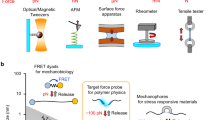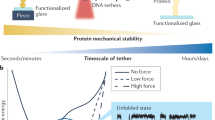Abstract
Force probes1 allow reaction rates to be measured as a function of the restoring force in a molecule that has been stretched or compressed. Unlike strain energy2, approaches based on restoring force allow quantitative molecular understanding3 of phenomena as diverse as translation of microscopic objects by reacting molecules4,5,6, crack propagation7,8 and mechanosensing9. Conceptually, localized reactions offer the best opportunity to gain fundamental insights into how rates vary with restoring forces, but such reactions are particularly difficult to study systematically using microscopic force probes10,11,12,13,14. Here, we show how a molecular force probe, stiff stilbene, simplifies force spectroscopy of localized reactions. We illustrate the capabilities of our approach by validating the central postulate of chemomechanical kinetics15—force lowers the activation barrier proportionally to the difference in a single internuclear distance between the ground and transition states projected on the force vector—on a paradigmatic unimolecular reaction: concerted dissociation of the C–C bond.
This is a preview of subscription content, access via your institution
Access options
Subscribe to this journal
Receive 12 print issues and online access
$259.00 per year
only $21.58 per issue
Buy this article
- Purchase on Springer Link
- Instant access to full article PDF
Prices may be subject to local taxes which are calculated during checkout




Similar content being viewed by others
References
Neuman, K. C. & Nagy, A. Single-molecule force spectroscopy: Optical tweezers, magnetic tweezers and atomic force microscopy. Nature Methods 5, 491–505 (2008).
Cremer, D. & Kraka, E. The concept of molecular strain: Basic principles, utility and limitations, in Molecular Structure and Energetics (eds Liebman, J. F. & Greenberg, A.) Vol. 7, 65–138 (VCH, 1988).
Reimann, P. Brownian motors: Noisy transport far from equilibrium. Phys. Rep. 361, 57–265 (2002).
Schliwa, M. (ed.) Molecular Motors (Wiley, 2003).
Browne, W. R. & Feringa, B. L. Making molecular machines work. Nature Nanotech. 1, 25–35 (2006).
Hugel, T. et al. Single-molecule optomechanical cycle. Science 296, 1103–1106 (2002).
Casale, A. & Porter, R. S. Polymer Stress Reactions (Academic Press, 1979).
Granick, S. & Bae, S. C. Stressed molecules break down. Nature 440, 160 (2006).
Vogel, V. Mechanotransduction involving multimodular proteins: Converting force into biochemical signals. Ann. Rev. Biophys. Biomol. Struct. 35, 459–488 (2006).
Schmidt, S. W., Beyer, M. K. & Clausen-Schaumann, H. Dynamic strength of the silicon–carbon bond observed over three decades of force-loading rates. J. Am. Chem. Soc. 130, 3664–3668 (2008).
Koti Ainavarapu, S. R. et al. Single-molecule force spectroscopy measurements of bond elongation during a bimolecular reaction. J. Am. Chem. Soc. 130, 6479–6487 (2008).
Wiita, A. P. et al. Probing the chemistry of thioredoxin catalysis with force. Nature 450, 124–127 (2007).
Kersey, F. R., Yount, W. C. & Craig, S. L. Single-molecule force spectroscopy of bimolecular reactions: System homology in the mechanical activation of ligand substitution reactions. J. Am. Chem. Soc. 128, 3886–3887 (2006).
Grandbois, M. et al. How strong is a covalent bond? Science 283, 1727–1730 (1999).
Hyeon, C. & Thirumalai, D. Measuring the energy landscape roughness and the transition state location of biomolecules using single molecule mechanical unfolding experiments. J. Phys. Condens. Matter 19, 113101 (2007).
Eelkema, R. et al. Molecular machines: Nanomotor rotates microscale objects. Nature 440, 163 (2006).
Nguyen, T. Q. & Kausch, H. H. (eds) Flexible Polymer Chains in Elongational Flow: Theory and Experiment (Springer, 1999).
Hickenboth, C. R. et al. Biasing reaction pathways with mechanical force. Nature 446, 423–427 (2007).
Sheiko, S. S. et al. Adsorption-induced scission of carbon–carbon bonds. Nature 440, 191–194 (2006).
Sotomayor, M. & Schulten, K. Single-molecule experiments in vitro and in silico. Science 316, 1144–1148 (2007).
Stirling, C. J. M. Evaluation of the effect of strain upon reactivity. Tetrahedron 41, 1613–1666 (1985).
Tani, K. & Stoltz, B. M. Synthesis and structural analysis of 2-quinuclidonium tetrafluoroborate. Nature 441, 731–734 (2006).
Carey, F. A. & Sundberg, R. J. Advanced Organic Chemistry (Springer, 2007).
Tobe, M. L. & Burgess, J. Inorganic Reaction Mechanisms (Longman, 1999).
Gajewski, J. J. Hydrocarbon Thermal Isomerizations (Elsevier, 2004).
Guner, V. et al. A standard set of pericyclic reactions of hydrocarbons for the benchmarking of computational methods. J. Phys. Chem. A 107, 11445–11459 (2003).
McMurry, J. E. Carbonyl-coupling reactions using low-valent titanium. Chem. Rev. 89, 1513–1524 (1989).
Cramer, C. J. Essentials of Computational Chemistry: Theories and Models (Wiley, 2002).
Jencks, W. P. A primer for the bema hapothle. An empirical approach to the characterization of changing transition-state structures. Chem. Rev. 85, 511–527 (1985).
Acknowledgements
The authors would like to thank J. I. Brauman, M. Gruebele, J. F. Hartwig, J. S. Moore, T. J. Martinez, K. S. Suslick and G. M. Whitesides for helpful discussions. The work was supported by the National Science Foundation (NSF) CAREER Award (CHE-0748281), the US Air Force Office of the Scientific Research Young Investigator Award (FA9550-08-1-0072), the American Chemical Society Petroleum Research Fund (48454-AC3 and 43354-G3) and the University of Illinois. T.K. thanks the Office of the Naval Research and the NSF for pre-doctoral fellowships. We gratefully acknowledge grants of computational time by the Air Force Research Lab Major Shared Resource Center and the National Center for Supercomputing Applications.
Author information
Authors and Affiliations
Contributions
Q.Y. designed and synthesized the macrocycles, Z.H. measured the kinetics, T.K. synthesized the macrocycles, D.K. carried out DFT computations of thermodynamic parameters and reaction coordinates, J.C. carried out preliminary MM and DFT calculations, R.B. designed the experiments, developed methods for calculating the restoring forces, analysed the results and wrote the paper.
Corresponding author
Supplementary information
Supplementary Information
Supplementary Information (PDF 6647 kb)
Rights and permissions
About this article
Cite this article
Yang, QZ., Huang, Z., Kucharski, T. et al. A molecular force probe. Nature Nanotech 4, 302–306 (2009). https://doi.org/10.1038/nnano.2009.55
Received:
Accepted:
Published:
Issue Date:
DOI: https://doi.org/10.1038/nnano.2009.55
This article is cited by
-
The many flavours of mechanochemistry and its plausible conceptual underpinnings
Nature Reviews Chemistry (2021)
-
Stiff-stilbene derivatives as new bright fluorophores with aggregation-induced emission
Science China Chemistry (2019)
-
Supramolecularly directed rotary motion in a photoresponsive receptor
Nature Communications (2018)
-
Nanoscale fiber-optic force sensors for mechanical probing at the molecular and cellular level
Nature Protocols (2018)
-
Up another rung
Nature Chemistry (2017)



